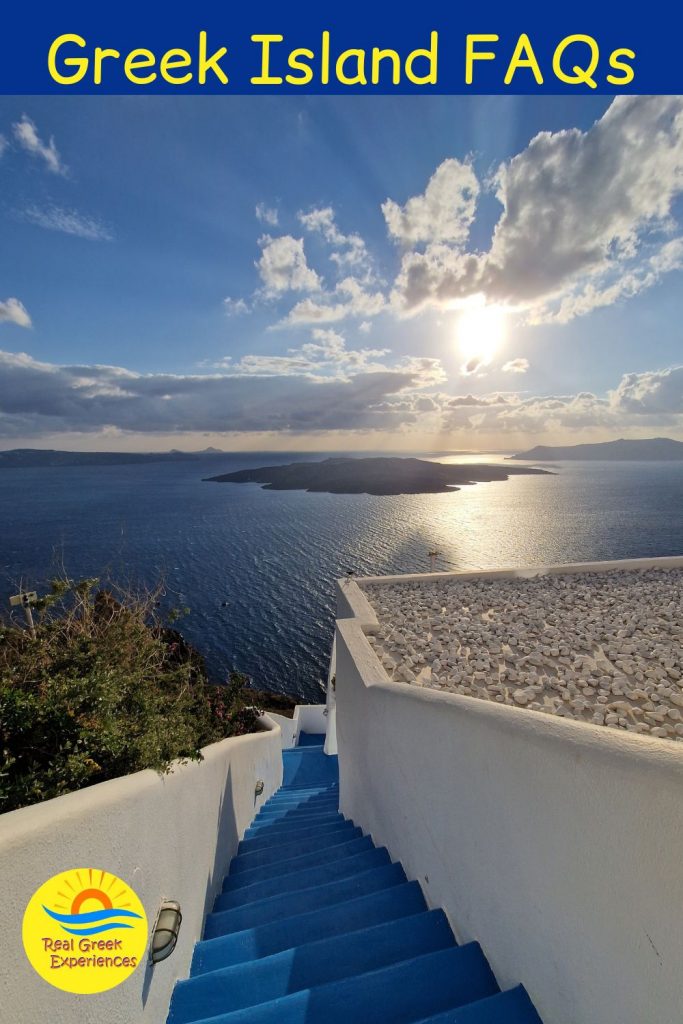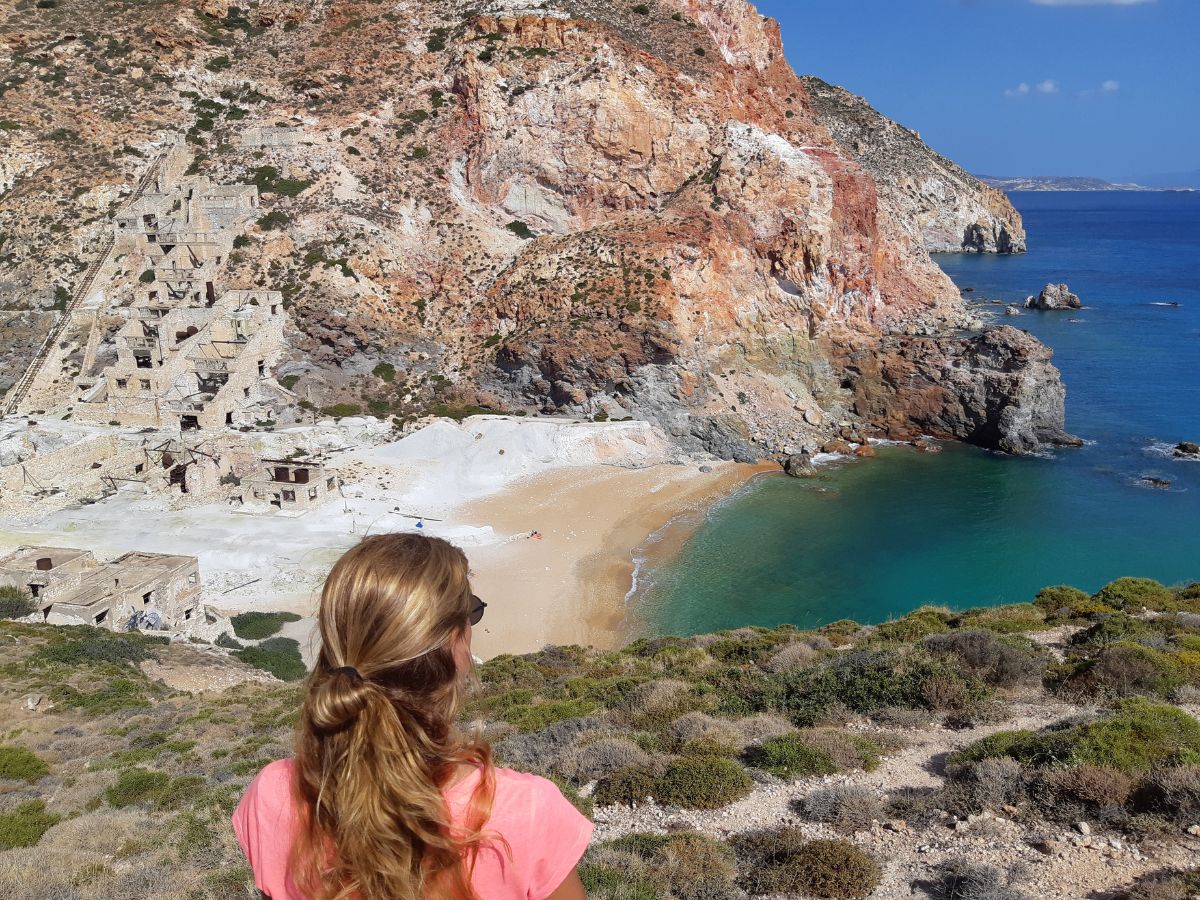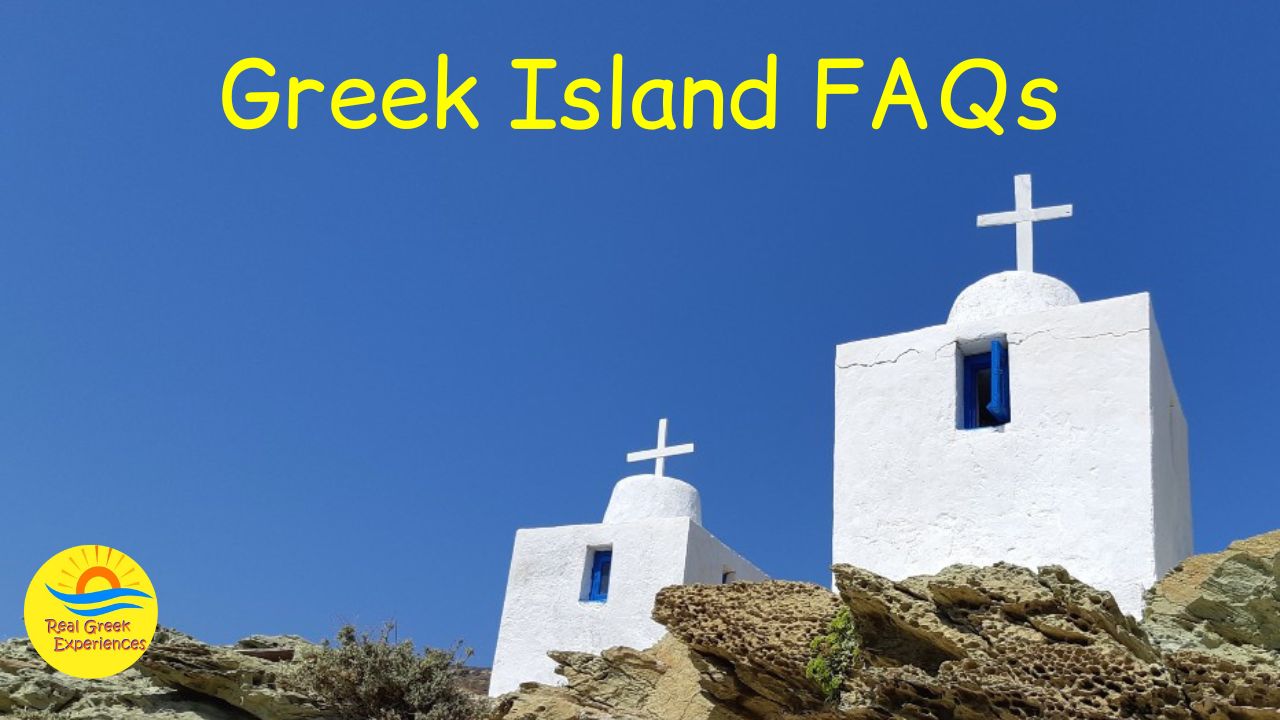
Planning a trip to the Greek islands and don’t know where to start? Here are 20 FAQs about travelling to the Greek islands to help you plan your dream trip!
Greek Island FAQs
Hello! I’m Vanessa from Athens and I’ve been to about 70 of the islands in Greece! So I thought I’d write this guide with 20 Greek island FAQs. I’ve added a little insider wisdom to make your island adventure even better!
I can also help you plan your personalised dream trip to Greece – click here for details!

1. When is the best time to visit the Greek islands?
The best time to visit the Greek islands is from April to October. August and July are peak season.
- June and September are ideal for most activities. You’ll get warm weather, swimmable seas, and fewer crowds than the peak of summer.
- July and August bring buzzing energy, more visitors, and higher prices for accommodation and car rentals.
- April, May and October are more relaxed and budget-friendly, and ideal for hiking and exploring – but the sea is not that warm, and you’ll probably get variable weather overall, plus many businesses will be shut down, especially on the smaller islands.
- If your priority is to swim, note that the sea can still be too cold in April, and even in May. It’s much warmer in August and September. I cannot stress this enough!
Here is my full guide: Best time to visit the Greek islands
2. What are some must-visit islands in Greece?
If you have a travel agent, they will probably try to convince you that Santorini and Mykonos are the two main must-visit islands in Greece. Having been to about 70 islands, I beg to differ!
Greece has dozens of inhabited islands, and most of them are special in their own way.
For example, Santorini is known for its volcano and jaw-dropping sunsets – but both Milos and Nisyros have unique volcanic landscapes as well!
Mykonos is known for its beautiful sandy beaches and wild party life – but you can find sandy beaches on several islands, including Naxos or Ios that are both nearby.
And as for the white-washed houses and blue-domed churches? You can see them on most of the Cyclades and the Dodecanese islands, plus a few more!
It really depends what you are looking for. Have a look at my introduction to the Greek island groups to get a better idea!
As for me? Some of my favourite islands are the quieter, less developed ones, like for example Sikinos, Folegandros, Donoussa, Karpathos and Kasos! But I also love Crete, which is endless!
I can help you decide the best Greek island(s) for you – just get in touch!

3. What should I pack for a trip to the Greek islands?
Pack light and breathable clothes, swimsuits, sunscreen, sunglasses, and a hat. Don’t forget comfy shoes for walking on cobblestones or hiking to hidden beaches.
A light sweater is handy for breezy summer nights, as well as air-conditioned ferries and museums. You’ll need to bring a few warmer clothes for early spring or fall.
Have a look at my full guides:
4. Are the Greek islands expensive to visit?
The short answer is that they can be, but don’t have to be!
Some of the better known islands, like Mykonos, Santorini or Paros, lean toward luxury. Others, like Naxos, Milos, Rhodes, Corfu or Crete, offer a mix of luxury and adventure.
However, there are dozens of islands that can be much more affordable, like for example Andros, Tinos, Nisyros, Kalymnos, Symi, Samos, Lesvos, Chios or Ikaria, to name just a few.
Travel in the shoulder season, stay in guesthouses, and eat at local tavernas to save cash without sacrificing any of the Real Greek Experience!
Here are some more tips: Island hopping in Greece on a budget
5. How do I travel between the Greek islands?
With few exceptions, the Greek ferries are the best way to travel between the Greek islands.
Some bigger islands also have airports, with domestic flights connecting via Athens. Depending on the islands you want to travel between, this could work out to be more time consuming and expensive than taking the ferry.
Have a look at my guides for travelling to / from the Greek islands:
- Tips for ferry travel in Greece
- Tips for flying to the Greek islands
- All the Greek islands with an airport
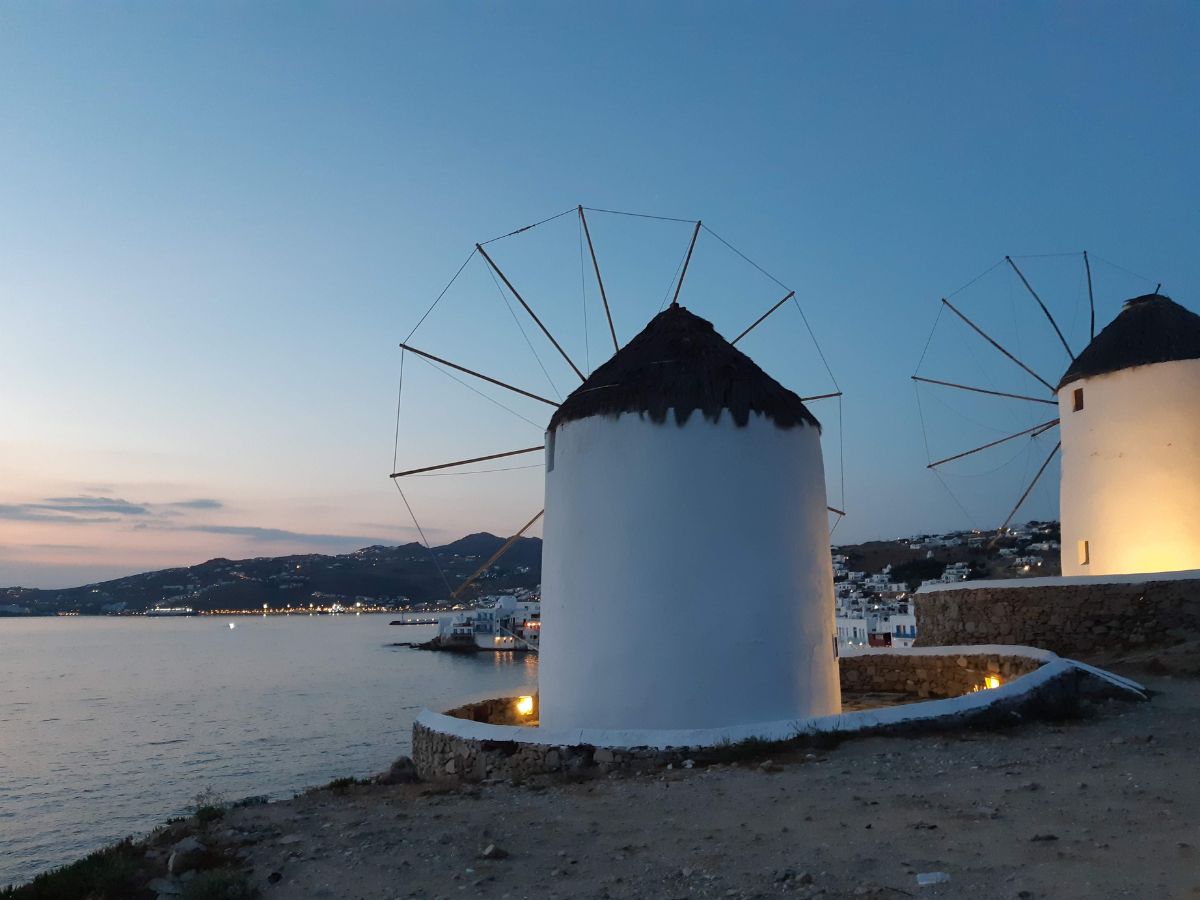
6. Is island-hopping easy to plan on my own?
Yes! You can easily book ferries online or through local travel agents. While many routes run daily in summer, be sure to check ferry connections in advance of your trip – some islands are better linked than others.
A rough itinerary definitely helps, especially if you are visiting Greece for the first time. However, if you are a spontaneous traveller, you can do last-minute detours – just accept the fact that you won’t always be able to find the exact accommodation you’d like.
Have a look at this helpful guide: How to plan your Greek island hopping trip, step by step!
7. How long should I plan to stay on each island?
This will generally depend on the size of the island. For example, you can stay in Crete for several weeks and still not see it all, while Koufonisia strictly only need a day or two, or you can even visit on a day trip from Naxos.
Generally speaking, try and plan for 3–5 days per island to truly relax, explore, and soak in the local vibe. If you’re just hopping over for a beach day or a quick tour, 1–2 nights could work.
But trust me – you really don’t want a Greek holiday full of packing, travelling and unpacking. Island transfers and ferries can take you longer than you think!
8. What activities are popular on the Greek islands?
One of the obvious activities is heading to the Greek islands’ beautiful beaches and diving into crystal waters. I personally love swimming and snorkelling, while other people I know prefer to laze on the beach.
There are soooo many other things to do on the islands though. You can explore ancient ruins, visit numerous museums, go into local churches and monasteries, hike on scenic trails, or even go kayaking and horse riding.
Island festivals with dancing and food, known as panigiria, are also unforgettable. There’s no better way to get a proper glimpse of Greek culture! Just ask the locals when the next festival is – there are plenty during the summer.
And of course, there are always organized activities you can take! Here is how to book in advance:
- Book activities on the Greek islands on Viator
- Book activities on the Greek islands on Get Your Guide
9. Are there family-friendly activities on the Greek islands?
Absolutely. Most islands have calm beaches and playgrounds, and there are always cultural sites for curious kids. Water parks and boat trips are popular as well.
One thing you should know is that Greeks love children. Families are warmly welcomed almost everywhere, from restaurants to beach cafés and laid-back beach bars. No need to go all-inclusive in Greece!
With that said, some Greek islands are less child-friendly than others. For example, many of the activities you’ll find on Santorini and Mykonos (e.g. wine tasting) are more geared towards adults, and several islands have areas more suitable for partying.
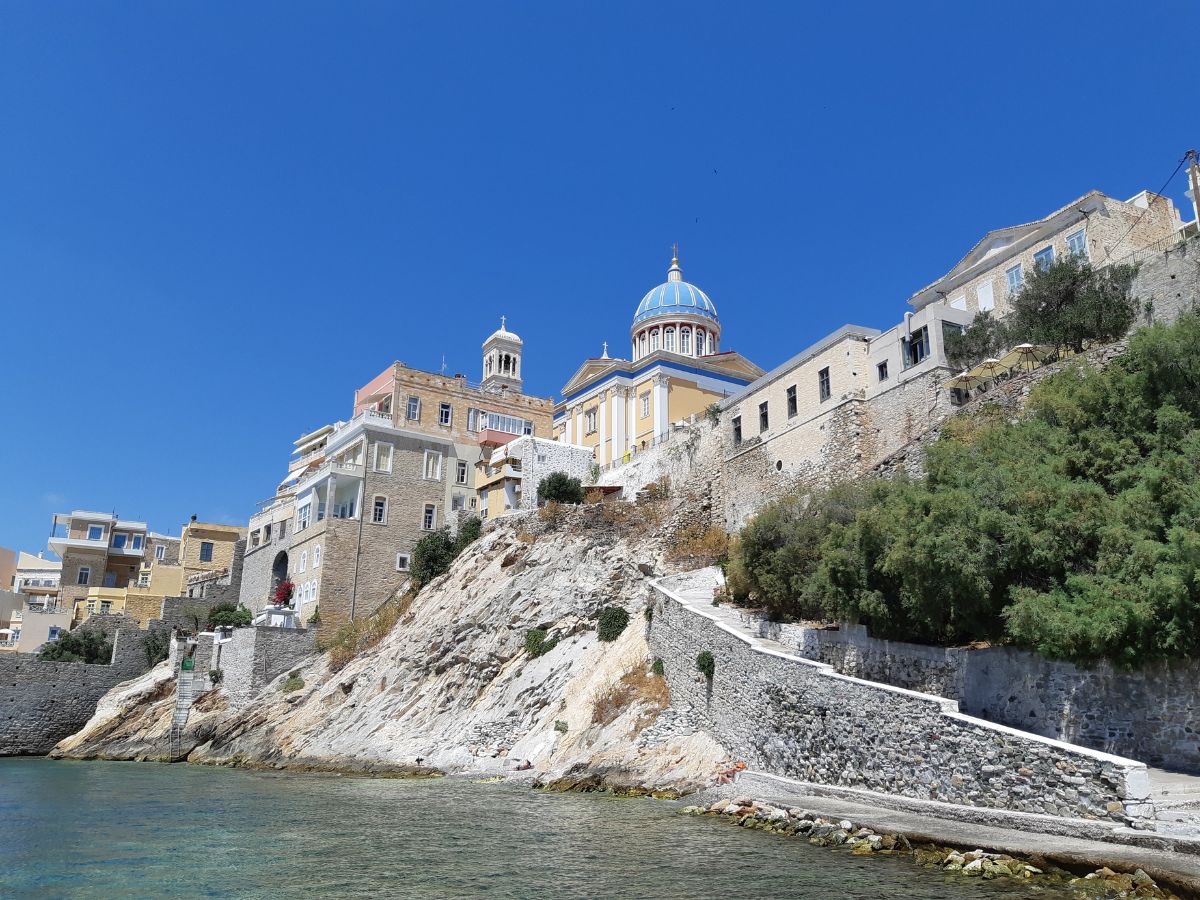
10. What’s the best way to get around “x island”?
This depends on the island you are going to, the time of year, and what you want to see. Many islands (e.g. Crete, Rhodes, Naxos, Mykonos, Santorini) have solid bus systems, so you don’t necessarily need to have your own wheels.
Still, a rental vehicle is often the best way to get around the island, as you can explore at your own pace and go wherever you want to. Scooters and ATVs can also be fun but can be tricky on hilly or gravel roads. If you decide to go for an ATV, please drive carefully – accidents happen more often than you’d think.
If you are visiting in peak season, parking can be an issue at the busiest areas – so, before you hire a car, see where you want to go first, as a bus, water taxi or transfer might be better. Also, make sure you read the following guides:
11. Is it safe to drink tap water on the Greek islands?
On some islands, yes, especially the larger ones like Crete. But on smaller islands, tap water is often not drinkable due to low rainfall and limited infrastructure.
It’s always best to ask the locals wherever you are. Or you can play it safe and stick to bottled water, which is cheap and widely available – though single-use plastic bottles aren’t that great.
Here is some more info: Can you drink tap water in Greece
12. Is it true that I can’t flush the toilet paper in Greece?
I know that this often comes as a shock to people, but it’s mostly true – the plumbing system at many areas of Greece doesn’t like toilet paper, let alone other items! You’ll often see the relevant signs when you go to the restroom.
Always ask the locals if you can throw paper in the toilet, and if in doubt, just use the bin provided – otherwise, you are risking a clogged toilet, which is not fun!
Here is some more info: Why you shouldn’t flush toilet paper in Greece
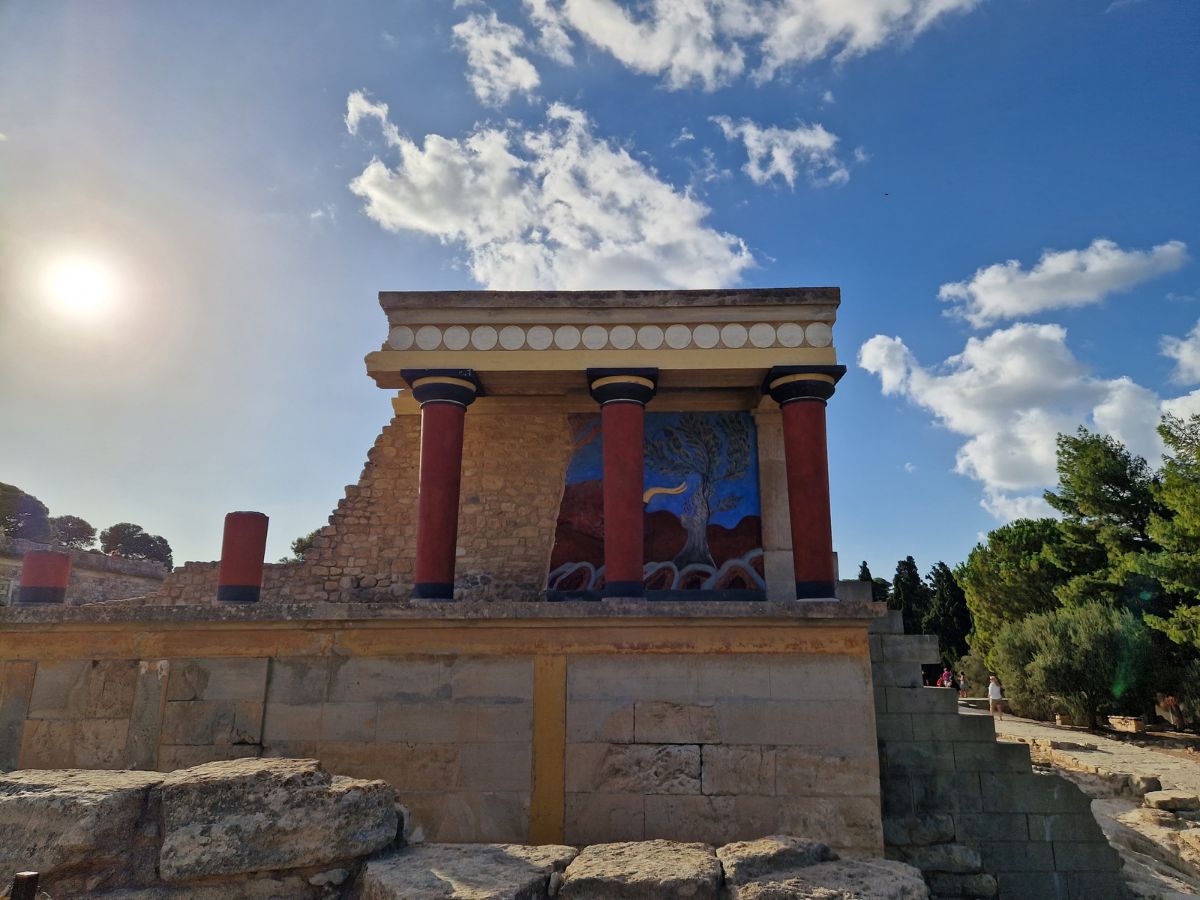
13. Are credit cards widely accepted on the Greek islands?
By law, credit and debit cards should be available everywhere in Greece. You’ll find that hotels, restaurants, and shops all take credit cards.
Still, it’s always smart to carry some euros, in case of a malfunctioning card payment machine – plus many businesses prefer cash anyway.
As for ATMs, they are available on most islands, though they can run out of cash in peak season. Just make sure you know what your bank charges you for to withdraw money abroad! Here’s a guide about money in Greece.
14. Do I need to tip at restaurants and cafés?
Tipping isn’t mandatory, or even standard, in Greece – but it’s definitely appreciated. Rounding up a restaurant bill, or leaving 5–10% is common. In cafés or bars, just leaving a euro or two is a nice gesture.
Overall, if you’re happy with the service, there is nothing wrong with tipping extra – people working in tourism will thank you for it! Here is my guide on tipping in Greece.
15. Do I need to speak Greek to get by?
Nope! English, and often a few more languages, is widely spoken in tourist areas. Still, learning a few Greek words like efharistó (thank you) or kaliméra (good morning) is appreciated and might just earn you a smile—or a bigger portion at dinner!
Have a look at my guides with some basic Greek:
- The Greek alphabet
- Useful Greek words and phrases
- Greek curse words – just for fun, but DO NOT OPEN AT WORK!
16. What are the local delicacies I should try in Greece?
Greece has a very varied cuisine! Some of the most iconic dishes that you’ll find everywhere in Greece are souvlaki, moussaka, Greek salad, grilled octopus, and dakos (Cretan salad).
At the same time, every island has its own specialty—like tomato fritters in Santorini or specially made stuffed vine leaves in Kasos.
And don’t leave without sipping ouzo or local wine with a seaside meal!
Here are some guides you’ll love:
- A guide with the 50 best dishes to try in Greece
- What to expect when you go to a Greek taverna
- The best drinks to try in Greece
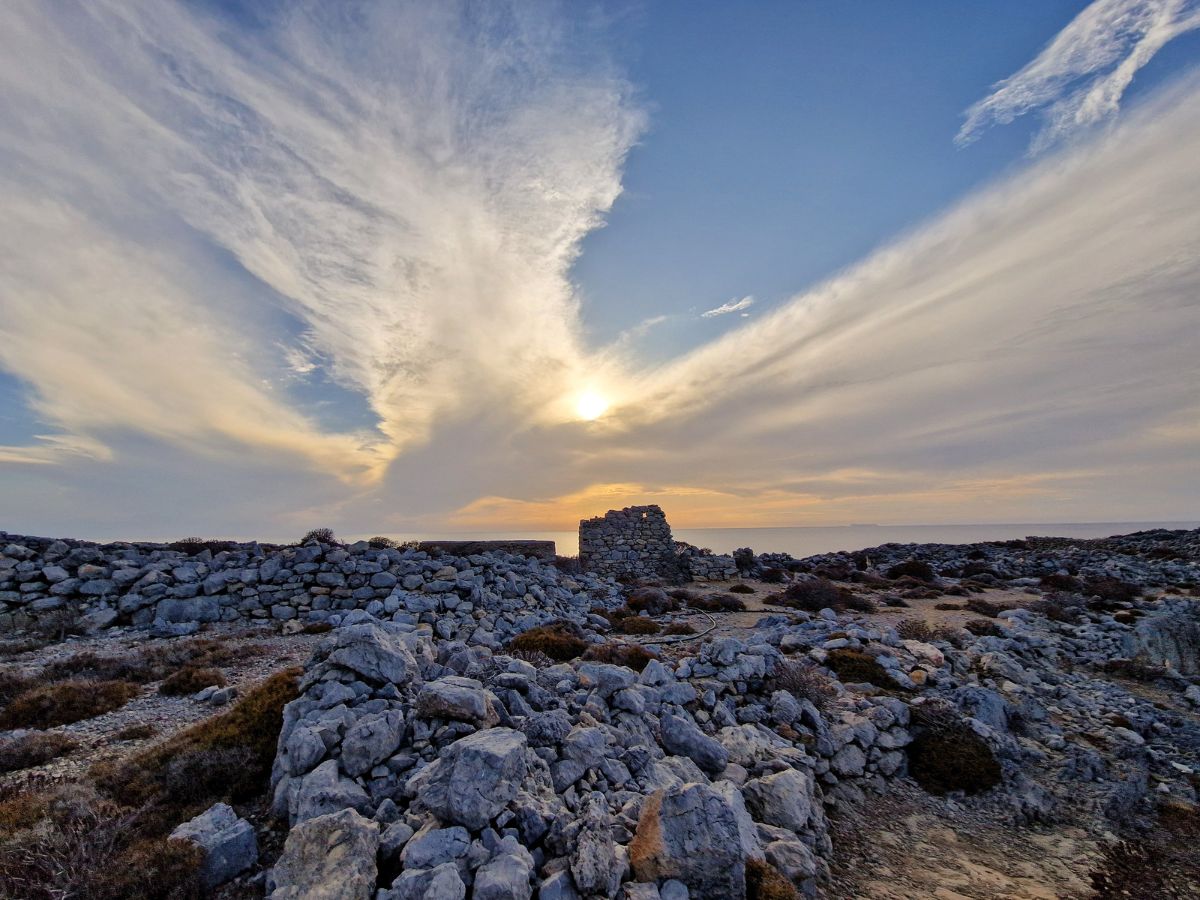
17. Are there vegetarian or vegan options on the islands?
Yes—more than you’d expect! Greek cuisine includes tons of veggie dishes like stuffed tomatoes, lentil soup, fava, and grilled vegetables. Most tavernas are happy to accommodate if you ask, and many places now offer fully vegan menus.
Here is my guide with traditional vegan Greek dishes for you to try!
18. Are there any cultural customs I should be aware of?
Greeks are warm and hospitable. Although tourism is a big industry here, most of the people you’ll meet are genuinely caring and they want you to have a good time – so make sure you say hello and acknowledge their effort!
Sharing food is common, and people never rush through a meal – it’s a social event, more about bonding rather than just eating. So, when you want the bill, you might have to ask for it! Lunches and dinners will usually be more late than what you are used to – though you can get a meal at most times of the day.
Please dress modestly at churches, with no bikinis or shorts. Also, respect the dress code for monasteries, where shoulders and knees shouldn’t be visible.
Apart from that,
19. Is Wi-Fi easily available on the islands?
These days, most hotels, restaurants, and cafés offer free Wi-Fi.
If you need a connection at all times, consider getting a local SIM card / e-SIM. Just note that the signal can be patchy in remote areas, for example if you hike to a secluded beach.
A good idea is to download offline Google Maps, so you can use them without interruption.
20. What’s the deal with siesta hours in Greece?
From around 2 to 5 pm, many shops and businesses take a break—especially in quieter towns. It’s a great time to nap, hit the beach, or enjoy a long lunch like a true local. Things pick up again in the evening!
So, there you go – these were some of the questions that people have asked me in the last few years! If you have more questions about your Greek island trip, feel free to drop them in the comments below!

Hi! I’m Vanessa from Athens and I like sharing things about my culture. Follow me on my social media:
